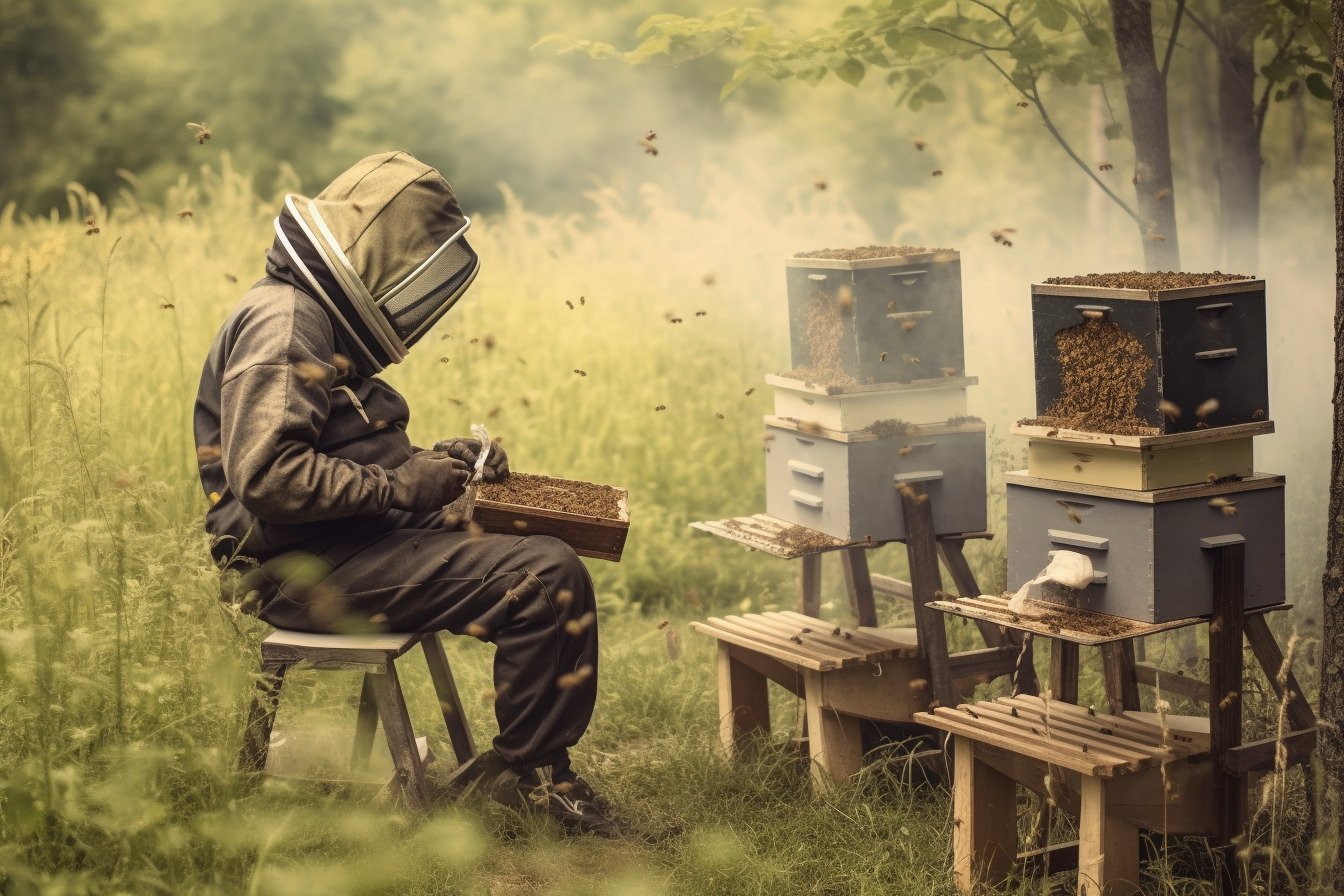Importance of Pollinators
Pollinators are a critical part of our environment, playing an indispensable role in global food production and biodiversity. They help in the fertilization of plants by moving pollen from the male parts to the female parts of flowers. This action not only aids in plant reproduction but also contributes to the genetic diversity of the plants.
Bees, in particular, are some of the most effective and crucial pollinators. Their body structure, behavior, and lifestyle make them perfect for this role. They are responsible for pollinating a vast number of our fruits, vegetables, and nuts, along with the plants that feed our livestock. It’s estimated that about a third of the food we eat depends on pollinators, particularly bees.
Myth of Smoking and Bees
A common myth surrounding beekeeping is the notion that smoke calms bees, making them less aggressive. This belief stems from the long-standing practice among beekeepers of using smoke while handling the hive. The prevailing thought is that the smoke induces a feeding behavior in bees or disrupts their alarm pheromones, essentially making them less likely to sting. However, the truth behind this myth and the potential impacts of smoke on bees are complex and warrant careful examination.
Unveiling the Truth about Bees and Smoke
How Bees Respond to Smoke
Bees have evolved a sophisticated set of behaviors to respond to perceived threats. The presence of smoke triggers an instinctive reaction, interpreted as a signal of potential danger, such as a forest fire. Consequently, bees prepare to abandon the hive, engorging themselves with honey for survival.
In this process, their abdomen becomes distended, making it difficult for them to sting. This change in behavior has been misinterpreted as a “calming” effect, whereas it’s really an emergency response.
Impact of Smoke on Bee Health
While the acute response to smoke may not directly harm bees, repeated exposure can have detrimental effects. Smoke can potentially damage the bees’ respiratory systems and hinder their ability to smell and navigate. It can also stress the bees, which can weaken their immune systems and make them more susceptible to diseases.
Furthermore, this practice of smoking bees should not be viewed in isolation. Bees are already facing numerous other stressors. Pesticides in the environment can poison them, while loss of habitat due to urbanization and intensive agriculture can deprive them of the diverse diet they need for good health. Each additional stress, including smoke, amplifies the overall impact on bee health and resilience.
Debunking the Myth: The Science Behind the Smoke
Bee Communication and Smoke
Bees communicate using pheromones, or chemical signals. When a bee stings or senses danger, it releases an alarm pheromone that alerts other bees to the threat. Other bees respond by becoming more defensive and are more likely to sting.
The introduction of smoke interferes with this pheromone communication. Specifically, smoke has been found to mask the alarm pheromone, reducing its effectiveness. This leads to the bees becoming less defensive – not because they’re calmer, but because they’re unable to smell the alarm pheromones.
However, this doesn’t mean the bees are unharmed. In fact, disrupting their communication can stress the hive and lead to long-term behavioral changes that may be detrimental to the colony’s overall health and survival.
Research Evidence Against Smoking Bees
Several research studies have shed light on the actual impact of smoke on bees. For instance, a study published in the Journal of Insect Science found that smoke exposure can decrease bees’ longevity and impair their navigation abilities. Another study revealed that it could affect their feeding behavior and learning capabilities, impacting the colony’s productivity.
These findings underscore the fact that the perceived calming effect of smoke on bees is not a benign phenomenon. Rather, it is an emergency response that can lead to stress and other negative health effects. Therefore, while smoke may be a tool for managing bees, it’s critical to understand its potential impacts and use it judiciously, if at all.
Sustainable Beekeeping Practices
Alternative Methods to Calm Bees
Given the potential negative impacts of smoke on bees, it’s worth exploring less harmful alternatives.
- Beekeeping Suits: Protective suits can help beekeepers handle bees with less risk of stinging, reducing the need for smoke.
- Gentle Handling: Simple techniques such as slow, gentle movements can avoid alarming bees.
- Sugar Water Spray: Spraying a light mist of sugar water can distract bees and make them less likely to sting.
- Time of Day: Working in the early morning or late evening when bees are less active can also reduce stinging risk.
Each of these methods has its own pros and cons, but all offer potential ways to manage bees without causing them undue stress or harm.
Advocacy for Bee-friendly Gardening and Agriculture
Aside from direct beekeeping practices, there’s much that can be done in the realms of gardening and farming to support healthy bee populations.
- Plant Diversity: Growing a diverse array of plants, including those that bloom at different times of the year, can provide bees with a steady source of nectar and pollen.
- Native Plants: Native plants are often more attractive to local bees and can be more resilient and less resource-intensive to grow.
- Pesticide Management: Limiting the use of pesticides or opting for organic or bee-friendly alternatives can greatly reduce harm to bees.
- Habitat Creation: Leaving some areas wild, providing fresh water, and even installing “bee hotels” can make your garden or farm a sanctuary for bees.
By integrating these bee-friendly practices, we can help ensure the health and survival of our vital pollinator populations.
The Broader Picture: Protecting Our Pollinators

The Threats Facing Bees Today
Bees face a multitude of threats in today’s world:
- Habitat Loss: As we develop land for human use, we often destroy the diverse habitats bees need to thrive.
- Climate Change: Changes in temperature and precipitation patterns can disrupt the timing of plant flowering, making it harder for bees to find food.
- Diseases and Pests: Bees are susceptible to a range of diseases and pests, which can spread rapidly through colonies.
- Pesticides: Many common pesticides are highly toxic to bees, and exposure can lead to both immediate death and long-term health impacts.
The decline in bee populations has serious implications for our ecosystems. Bees play a critical role in pollinating many of the plants that make up the world’s ecosystems. Without them, these plants could fail to reproduce, leading to declines in plant diversity, and impacting the entire food chain.
Actions for Protecting Bees
There are several actions that individuals and societies can take to protect bees:
- Gardening: Planting a bee-friendly garden with a diverse array of native plants that bloom throughout the year.
- Reducing Pesticide Use: Opting for organic or less harmful alternatives to common pesticides.
- Promoting Native Plants: Planting native plants in our gardens and landscapes to provide bees with the food and habitat they need.
At a broader level, we need policy changes to protect bee habitats, limit the use of harmful pesticides, and support bee-friendly farming practices. We also need more research to understand the complex threats bees face and how best to protect them.
Every one of us can contribute to these efforts and help ensure the survival of our vital pollinators.
Conclusion
The Importance of Dispelling Myths
Through this exploration, it becomes clear how critical it is to debunk myths surrounding bee behavior and beekeeping practices. Misunderstandings can lead to practices that, while traditional, may not be in the best interest of the bees or the ecosystems they support. As we’ve discovered, the common practice of smoking bees is one such myth that needed a more critical examination.
By becoming more informed, we can make better decisions and encourage others to do the same. The call to action here is twofold: spread the awareness gained from debunking such myths and adopt bee-friendly practices in our daily lives. Whether you’re a beekeeper, gardener, or simply a concerned citizen, your actions can contribute significantly to the protection of bees.
The Future of Bees and Pollinators
Our future is intricately tied with the future of bees and other pollinators. If we fail to protect them, we risk severe consequences. A decline in bee populations can lead to a decrease in the production of crops that rely on pollination, which in turn can affect food security.
Furthermore, the loss of bees can have ripple effects throughout ecosystems, affecting other wildlife and plants, and ultimately human populations too. These potential scenarios underscore the importance of collective action in protecting bees and other pollinators.
Protecting our pollinators isn’t just about safeguarding our future food supply; it’s about preserving the biodiversity and health of our planet. By dispelling myths, changing our practices, and advocating for bees, we can contribute to a brighter, more sustainable future for all.
